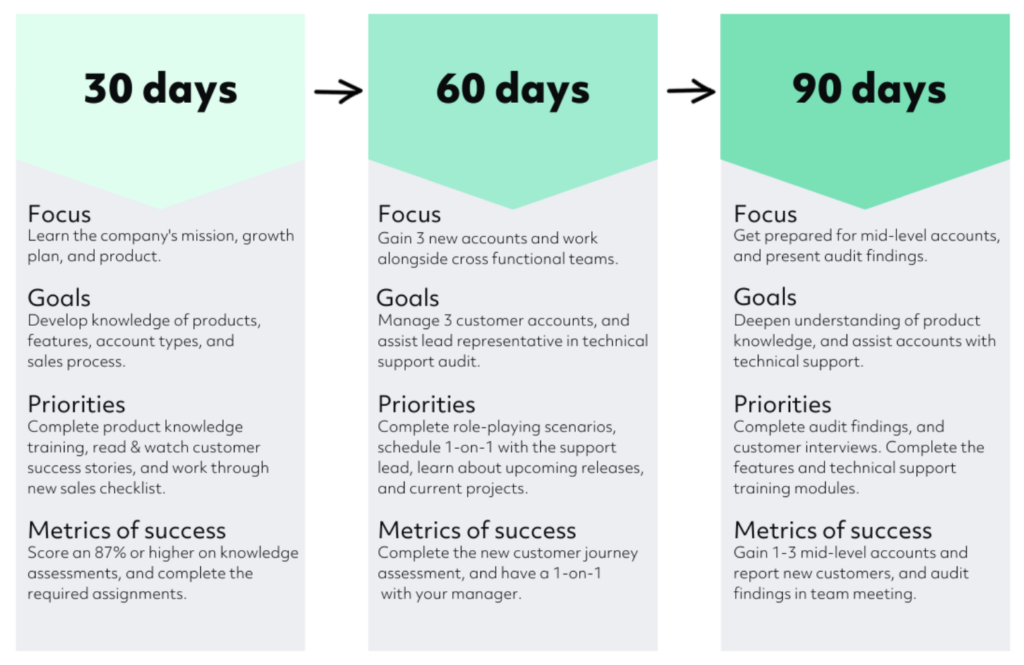The First 90 Days: A Blueprint for New Hire Retention Success
Published on Mar 7, 2024

The first 90 days after hiring a new salesperson are make or break. Make them feel welcome, get them up-to-speed quickly with efficient onboarding, and help them build team connections, and you stand a much greater chance of new hire retention.
On the other hand, failing to check these boxes can put them at far greater risk of premature turnover. Poor onboarding in particular is problematic, as 80% of new hires who receive lackluster onboarding say they plan to quit soon.
In this post, I’ll offer a simple blueprint for the first 90 days of a new salesperson’s tenure so you can get them plugged into your team, equip them for success, and dramatically increase new hire retention.
Create a Welcome Package
First impressions are everything. If you go out of your way to make a new sales rep feel welcome and quickly get their bearings, it sets a positive tone moving forward.
One of the best ways to do this is by creating a standard welcome package for every new hire, which “is a collection of paperwork, resources, information, and welcome items.” Here are some common things you may want to include:
- A welcome letter
- Team member directory
- Office and parking lot layout information
- An overview of your company culture
- WiFi login info
- Workplace policies
- Recommended local restaurants and shops
You may also want to include some gifts like company apparel, books, or a gift card to get started out on the right foot. Here’s an example of what Salesforce includes in its welcome package.
For a detailed overview of how to create your own custom welcome package, I suggest reading this post from HR software company Eddy.
Offer Structured, Phased Onboarding
Research has found that “organizations with strong employee onboarding can increase retention by 82%.” However, a large number of today’s companies (36%) lack a structured onboarding process.
These numbers tell us that, by default, optimizing your onboarding process should put your brand in the top two-thirds, and there should be a tangible impact on retention. More specifically, it’s best to develop a structured onboarding system that moves in phases, allowing salespeople to gradually grow and build their skills without overwhelming them.
Here’s a simple example of what it may look like where phases are broken down into 30-day increments.
During the first 30 days, there’s a focus on the basics like understanding your company’s mission, learning the ins and outs of products, and identifying priorities. From 30 – 60 days, a rep is expected to gain three new accounts and manage three existing accounts. And from 60 – 90 days, a rep prepares for mid-level accounts, builds on their product knowledge, and so on.
Again, this is an oversimplified version of onboarding, but it shows how having a clearly defined system that lays the groundwork for incremental progress can help get a salesperson firing on all cylinders.
Have Routine Check-Ins
Whether it’s keeping tabs on a new salesperson’s progress, answering questions or concerns, or just chatting about their overall experience, maintaining a clear line of communication should go a long way in helping a rep reach their full potential while also providing a positive experience. This is especially important during the first 30 days when a person is just learning the ropes and should help any minor issues from escalating into larger ones.
Ideally, you’ll have a dedicated senior team member check in at regular intervals with each new hire. And always be sure that you 1) have an open door policy where reps know they can promptly get in touch with someone whenever they need to and 2) encourage them to initiate a discussion.
This brings us to the final part of the new hire retention formula.
Facilitate Relationship-Building
Another common barrier to retention is a lack of connectedness or, in many cases, loneliness — something that’s become quite common in the modern workplace. And we’re not just talking about remote workers. In total, 82% of employees said they felt lonely at work during a 2022 study.
Needless to say, if someone feels like they’re on an island, they’re unlikely to experience a high level of job satisfaction. When this happens at scale, it can create a serious turnover problem.
In terms of a solution, it largely boils down to being proactive about facilitating relationship-building. I like what The Harvard Business Review has to say about it.
“Building relationships during their first year can help new hires feel less isolated and more confident. New hires, in partnership with their manager, should identify 7-10 people — superiors, peers, direct reports, and internal and external customers — whose success they will contribute to, or who will contribute to their success. The new hire should then craft plans to connect with each stakeholder, one-on-one, during their first year.”
While your game plan doesn’t necessarily have to be as comprehensive as this, creating strong relationships should be a priority and is integral to building a winning culture.
New Hire Retention: Making the First 90 Days Count
With a third of salespeople quitting their jobs within the first 90 days, this is a critical time to go above and beyond. While there’s a lot that goes into maximizing new hire retention, four key areas to focus on are properly welcoming new salespeople, providing them with adequate onboarding, maintaining close communication, and helping them truly become part of the team.
By checking these boxes, you can help them get plugged in and fully integrated with the least amount of friction. In turn, you can reap the rewards of low turnover by reducing recruiting costs, strengthening company culture, boosting morale, and much more.
And if you’re looking to recruit the best of the best salespeople in your industry, check out the Objective Management Group sales assessment. It focuses on core competencies to find candidates who are not only great salespeople but who are equipped to thrive in your unique selling environment.

